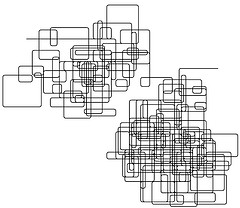I spent a very interesting evening at the Frontline Club for the launch of Face The Future on Tuesday. Judith Townend, Kevin Marsh, Laura Oliver (who’s moved to the Guardian recently) and chair Raymond Snoddy discussed a pretty wide-ranging selection of subjects related to the future of journalism and the tools we’re using to create it.
The evening was an interesting reminder, for me, that those of us who tweet constantly and feel on top of new tech are still, overwhelmingly, the minority. It’s easy to forget, if you spend time learning about social media and talking about new tools for the future of journalism and generally being digitally disruptive, that that’s not the reality for most journalists.The fact that I was the only person tweeting for most of the evening was one small reminder; the demographics of the audience was another; Raymond Snoddy admitting he just about felt like he was on top of the technology until someone mentioned Quora was another.
And there was a timely reminder from Kevin Marsh that in the middle East, where so much information is coming via Twitter at the moment, the same holds true. It’s a specialised tool, and journalists in particular do specialised things with it – it’s relevant and timely and a great way to source stories, but it doesn’t open up access the same way that being there in person does.
But that was another major theme of the evening – that despite major news teams being capable of sending journalists around the world, the pressures of filing to half a dozen places can make it impossible for journalists to do their jobs well. Kevin gave examples from his knowledge of the BBC – journalists doing live broadcasts for the rolling news channels, recorded spots for lunchtime and evening news and possibly breakfast too, tweeting, perhaps doing radio, and blogging too. Where’s the time for journalists to leave their hotels and investigate, go out on the streets and find sources?
Closer to home, too, the debate touched on the problems for domestic reporters – Raymond Snoddy spoke of newsrooms where no-one leaves, not even for lunch, and characterised the reporters as working on “computerised treadmills”, churning out copy to feed the ravenous information machine.
The conclusion was – this type of reporting is not lazy journalism. The journalists involved are working harder than they ever have before, producing more copy, more broadcasts, more information. But the trade-off is in time spent in the field, investigating, asking questions, finding sources, doing the hard work behind the scenes that makes for good journalism. And that’s something I can identify with, too – even in my short career I’ve experienced a newsroom merge and a round of redundancies, and I can vouch for the fact that fewer staff, cutting costs and increasing numbers of platforms for your reporting mean more time at the desk or the phone and less time on your patch or with your sources, no matter how good your intentions.
The panel also agreed that what’s important is support, from editors and from news executives, for the core skills and values of journalism. What’s important isn’t just that reporters want to get out and report – what’s needed is a newsroom structure that supports and encourages that, and a business model that puts this core area of journalism at its heart and gives it everything it needs to thrive.
The discussion wove together issues of verifying information when breaking news is breaking faster than ever before, with the tricky problems of regaining readers’ trust in a world where the phone hacking inquiry is ongoing, with questions of how journalism itself is defined. And in the end, though both Laura and Judith made the point that new forms of information management and presentation have value – that aggregation is important and curation and filtering are vital, in a world where the same sources we use are also open to the audience – it was Kevin’s argument that stuck with me. He said that we have forgotten what journalism is, and in so doing we have allowed it to become devalued.
Kevin’s list of what journalism is and how it works was not exhaustive or scientific. He talked of journalistic values – accuracy, balance, ethics – and of reporters’ traits – curiosity, ability to speak truth to power, perseverance. He talked about a sort of journalism stamp – something that would signal strongly to readers that they were reading something professional, something that adhered to the central values of journalism – a hard task, in a world where no one trusts the PCC and we have no better accreditation. His definition of journalism would cheerfully include a huge raft of bloggers, freelancers and, yes, curators, while excluding half the Daily Mail and all of the Daily Star.
But what wasn’t clear was how we pay for that. One audience member asked, in so many words: where’s the money? And though the response was robust – if the BBC and Sky can’t pay for good journalism out of their enormous budgets, the problem is with the management not the journalism – it was not enough to leave me with any real ideas about how we reach this world where Kevin’s “j-stamp” both exists widely and can be trusted.
Newsroom support, rebuilding readers’ trust, and a journalistic practice that prioritises those core ethics before eyeballs or speed of filing is a lofty aim. There are hundreds of bloggers who are beating “professional” journalists at these things, day in, day out, because they believe it matters. Whether it’s a future that mainstream journalism can hope to achieve is an open question.


